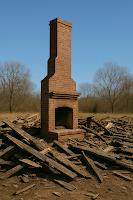One incident stands out vividly. He and his crew had just completed the hearth and chimney for an imposing multi-story home. A critical error in the blueprints caused the hearth to be misaligned by several inches, a minor flaw that compromised the living room’s aesthetic balance. The homeowners were adamant that this mistake be corrected. Unfortunately, moving the entire house would have been far easier than relocating the chimney. The only solution was to demolish the chimney, a job for which I was immensely qualified by virtue of youth.
Armed with a hammer and chisel, I eagerly embarked on the task. Perhaps it was the reprieve from the drudgery. It could have been the subconscious instinct that sons have to destroy the world created by their fathers. More likely, it was my generation’s zeitgeist of “sticking it to the man.” Regardless, I took to the task with glee. The sledgehammer became an extension of my adolescent frustration, and each falling brick a symbolic act of rebellion against the oppressive constraints of bourgeois architecture. My father, however, viewed the situation with weary frustration, offering only a stern rebuke: "Any jackass can kick down a barn."
His words, though dismissive, contained a profound truth. Chimneys are far more than mere stacks of brick. They are complex structures, the product of centuries of evolving design and a testament to human ingenuity in harnessing fire while mitigating its dangers. They must simultaneously contain the flames, channel poisonous fumes, and repel the elements. They rise taller than the homes they serve while balancing their massive weight without external support. Chimneys are remarkably resilient, often standing for decades after the rest of the building has succumbed to fire, water, wind, and time.
Knocking down a chimney is child's play compared to constructing a functional and aesthetically pleasing one. Demolition requires no finesse or insight. One only has to strike at a few critical points and let gravity do the rest. True mastery, however, lies in the creative process—in carefully laying each brick, ensuring the structure's stability, and achieving a harmonious blend of form and function. The same type of creative process is fundamental to healthcare.
Our healthcare system was constructed brick by brick. The infrastructure that supports it was likewise the result of an evolving design. Each part, from medical education to health care financing, developed organically as we collectively sought to improve the health and well-being of all citizens. The edifice of healthcare is like a Jenga tower. The Medicare program was stacked on the Social Security Act. The Medicaid program was wedged precariously between federal and state budgets. Employer-sponsored health insurance was propped up on World War II-era tax policies. Each brick relies on the structural integrity of all the others. Pull out the wrong brick, and the entire tower may collapse.
As I read news reports of tech nerds from the “Department of Government Efficiency” invading federal agencies, freezing expenditures, censoring NIH, NSF, and CDC websites, capping research funding, and stripping the Agency for International Development of its ability to deliver essential life-saving resources, I was reminded of the teenager I used to be, knocking down the old man’s chimney. These actions appear to be guided by the prevailing Silicon Valley philosophy: Move fast and break things.
This philosophy of prioritizing disruption and weeding out perceived inefficiencies may be appropriate in digital technology. However, destructive innovation only works when the risks of failure are relatively low, and the only people harmed are venture capitalists with unlimited resources. Applying this principle to medicine and public health is cruel and immoral. How many infants died as USAID food and medicine lay rotting on loading docks? How many new cases of AIDS will result from the abrupt discontinuation of the PEPFAR program? How much ground did we lose preparing for the next epidemic due to the summary firings of investigators and scientists at the CDC?
A measure of disruption is necessary for progress, and our nation’s healthcare bureaucracy certainly needs to be reformed. Family physicians have consistently pointed out the deficiencies in our system. It discourages primary care. It fails to serve the needs of women, minorities, and the poor. And it consistently outspends its peer countries while our life expectancy lags. Reform is essential but must be tempered with respect for human well-being and societal values.
Healthcare is not a misplaced chimney that can be swiftly torn down and rebuilt. Our institutions are complex structures built for long-term stability, relying on careful deliberation and oversight. Embracing a "move fast and break things" approach here is a dangerous folly. To demolish these vital foundations without a blueprint for their replacement invites chaos and the daunting task of picking up the broken pieces.
It took practically no time for me to knock down that chimney so many years ago—I moved very fast and broke things recklessly. It took much more time to clean up the rubble, another job that fell to me. As for the replacement, my father built it back—a few inches to the left—in his usual diligent style. Since I was an oblivious teenager, I had no idea how much this mistake cost my father, professionally or personally. He died over 30 years ago, so I can’t ask him now. However, I am sure that his chimney still stands.
